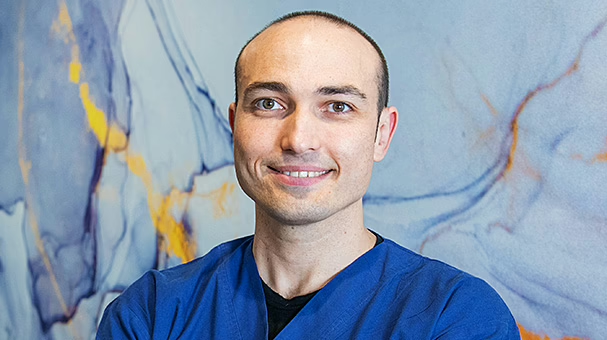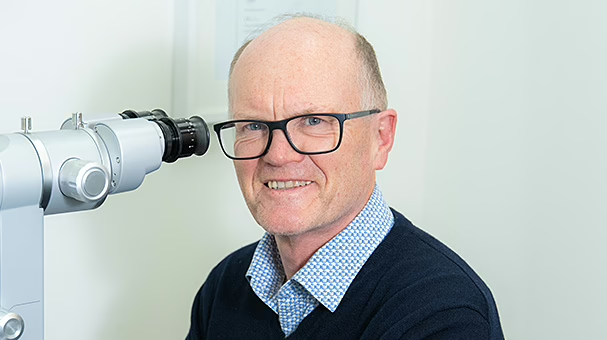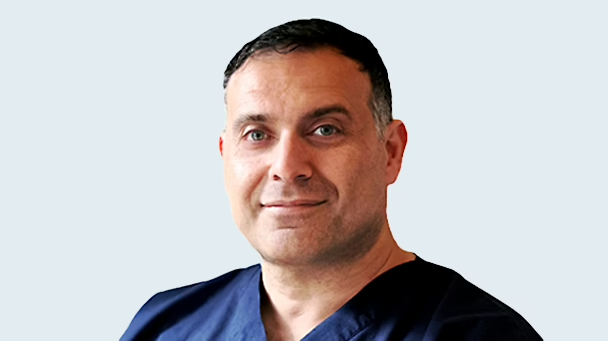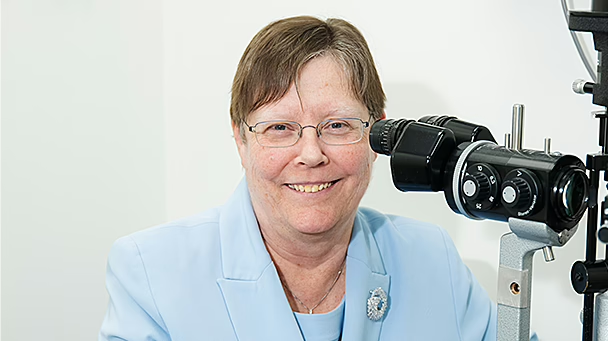Diagnosing macular degeneration
Regular eye examinations
Everyone should have their eyes checked on a regular basis by an optometrist, regardless of whether you require glasses to see. Your optometrist will check your vision and also look for signs of any other eye disease. This is particularly important for conditions such as macular degeneration, where there may not be any noticeable visual abnormalities until late in the disease course. If there are any abnormal signs or you are in a high-risk group (e.g. you smoke, have diabetes or a family history), your optometrist may recommend further tests to examine the retina and can refer you to a retinal specialist.
If you have difficulty reading, distinguishing faces, or start to see dark or empty patches in your central vision, have your eyes checked immediately.
Home screening
You can perform some simple screening tests for macular degeneration at home. For those over the age of 50, look at a straight edge (e.g. of a door or window) one eye at a time to see if there are any ‘bumps’ or missing parts to the line. If there are, have your eyes checked immediately.
An Amsler Grid may be recommended for people at high risk of developing macular degeneration. Named after Swiss ophthalmologist Marc Amsler, this grid contains a series of horizontal and vertical lines with a dot in the middle. If the lines appear wavy or any are missing, have your eyes checked immediately.
Fluorescein angiography
This test (sometimes called retinal photography or eye angiography) uses a fluorescent dye to show any blockages or leaks in the blood vessels supplying the retina. The dye is usually injected into a vein in your arm and flows through the blood system to the retinal blood vessels. Your ophthalmologist will use a special camera to take photographs. Please note that your vision will be blurred for up to 4–6 hours after the test, as your pupil will be dilated using eye drops.
Optical coherence tomography (OCT)
Optical coherence tomography (OCT) is a non-invasive test that captures detailed images of the retina. The scan allows the ophthalmologist to identify areas of retinal thinning, thickening, or swelling caused by fluid build-up and leaky blood vessels. Your pupils will be dilated for this test and the procedure takes less than 10 minutes. As the OCT scanner is a kind of camera, it does not need to touch your eyes.
Treatment for wet macular degeneration
There is no cure for wet macular degeneration, although some treatments can slow or stop progression of the disease and vision can be maintained (or even improved) for many people.1
The benefits of early treatment are:
- Less damage to the macula caused by the abnormal blood vessels
- Less oedema (swelling caused by excess fluid) in the macula, which would otherwise distort its shape and position
- Prevention of scar tissue and the abnormal membrane that can form under the retina and damage macular tissue
- Reduced chance of losing central vision
Eye (intravitreal) injections
Eye injections are the gold standard treatment for wet macular degeneration. They can be used to stop abnormal blood vessels from leaking and dry up the abnormal macular fluid (oedema). Repeated injections and regular monitoring can prevent further vision loss in 95% of sufferers.2 Vision is significantly improved in up to 40% of those treated.3 Most patients receiving eye injections will require regular, lifelong treatments to maintain their vision.
Anti-VEGF eye injections
Vascular Endothelial Growth Factor (VEGF) is a protein secreted by oxygen-deprived cells. Low levels of VEGF are normal; however when there are high levels of this protein, abnormal blood vessels will grow. Anti-VEGF drugs block the protein and the corresponding abnormal blood vessel growth – they are given as eye injections. These drugs are used in the treatment of macular degeneration and diabetic retinopathy.
Anaesthetic drops are used to numb the eye, and the injection is given via a tiny needle from the side – you won’t be able to see the needle coming towards your eye. You may feel slight pressure, but there won’t be any pain.
Photodynamic therapy (PDT)
Photodynamic therapy is occasionally used for a small number of patients who have a specific type of AMD. A special dye, known as a photosensitiser, is injected into an arm vein and flows through the blood system to the retinal blood vessels at the back of the eye. A cold laser is then used to activate the dye, with the resultant photochemical effect shrinking and sealing abnormal blood vessels. Many people will need to be treated about every 3–4 months.
Eye injections may be used in conjunction with photodynamic therapy.
Treatment for dry macular degeneration
Unfortunately, there is no approved treatment for patients with the dry form.
Research studies investigating disease progression and potential therapies, some of which involve Vision Eye Institute specialists, are currently ongoing.
Preventing macular degeneration
Quit smoking
Smokers are three times more likely to develop macular degeneration4 (in addition to a number of other serious health-related issues), so now is the time to quit.
Eat fish, green and gold
Research has shown eating foods rich in carotenoids are particularly beneficial.5 These include dark green leafy vegetables (e.g. spinach and kale) and coloured vegetables (particularly gold-coloured ones, e.g. corn, yellow capsicum, sweet potato). Foods rich in vitamin C, omega-3 fatty acids (e.g. oily fish such as salmon) and zinc are also good for eye health.
Clinic team
NSW
-



Dr Christopher Go
BMed MD MPH MMed FRANZCO
Locations
- Drummoyne
- Hurstville
- Tuggerah Lakes
Book a consultationwith Dr Christopher Go
QLD
SA
-

Dr Paul Athanasiov
MBBS FRANZCO MMed (OphthSc) MOphth
Locations
- North Adelaide
- Windsor Gardens
- Kurralta Park
Book a consultationwith Dr Paul Athanasiov
Dr Simone Beheregaray
MD PHD FRANZCO
Locations
- North Adelaide
- Windsor Gardens
- Whyalla
- Brisbane
Book a consultationwith Dr Simone Beheregaray

Dr Soo Khai Ng
MBBS FRANZCO
Locations
- Kurralta Park
- North Adelaide
- Windsor Gardens
- Elizabeth
- Whyalla
Book a consultationwith Dr Soo Khai NgVIC
-

Dr Devinder Chauhan
MBBS MD FRCOphth FRANZCO
Locations
- Boronia
- Box Hill Retinal Clinic
Book a consultationwith Dr Devinder Chauhan
Dr Jeremy Diamond
MB ChB, PhD, FRCS, FRCOphth, FRANZCO
Locations
- Boronia
Book a consultationwith Dr Jeremy Diamond
Dr Eric Mayer
BMBCh PhD FRCOphth FRANZCO
Locations
- Box Hill Retinal Clinic
Book a consultationwith Dr Eric Mayer
Dr John McKenzie
MBBS FRACS FRCOphth FRANZCO
Locations
- Footscray
Book a consultationwith Dr John McKenzie

Dr Christolyn Raj
MBBS(Hons) MMed MPH FRANZCO
Locations
- Blackburn South
- Camberwell
- Coburg
Book a consultationwith Dr Christolyn Raj
Dr Mei Tan
MBBCh BAO PhD FRCOphth FRANZCO
Locations
- Camberwell
- Coburg
Book a consultationwith Dr Mei Tan
Dr Aaron Yeung
MBBCh, PhD, FRCOphth, FRANZCO
Locations
- Footscray
Book a consultationwith Dr Aaron Yeung
Dr Brian Ang
MBCHB FRANZCO FRCOPHTH FRCSED (OPHTH)
Locations
- Blackburn South
- Footscray
Book a consultationwith Dr Brian Ang
Dr Sky Chew
MBBS BMedSc MMed FRANZCO
Locations
- Boronia
- Box Hill Retinal Clinic
- Coburg
- Footscray
Book a consultationwith Dr Sky Chew
Dr Jonathan Goh
MBBS BMedSc PGDipSurgAnat MS FRANZCO
Locations
- Footscray
Book a consultationwith Dr Jonathan Goh
Dr Elvis Ojaimi
MBBS MMed FRANZCO MD
Locations
- Boronia
- Box Hill Retinal Clinic
Book a consultationwith Dr Elvis OjaimiReferences
1. Vision Australia. Age related macular degeneration [Internet]. Australia: Vision Australia; [date unknown] [cited 2021 Jan 27]. Available from: https://www.visionaustralia.org/information/eye-conditions/Aged-Related-Macular-Degeneration
2. Baumal. Wet age-related macular degeneration: treatment advances to reduce the injection burden. Am J Manag Care. 2020 May;26(5 Suppl):S103-S111. doi: 10.37765/ajmc.2020.43435.
3. Haddrill. Macular degeneration treatment, FDA approved [Internet]. Irving (Texas): All About Vision; [date unknown] [updated 2018; cited 2021 Jan 27]. Available from: https://www.allaboutvision.com/conditions/amd-treatments.htm
4. Macular Disease Foundation Australia. Risk factors [Internet]. Sydney (NSW): Macular Disease Foundation Australia; [date unknown] [cited 2021 Jan 27]. Available from: https://www.mdfoundation.com.au/content/risk-factors-macular-degeneration
5. Wu et al. Intakes of lutein, zeaxanthin, and other carotenoids and age-related macular degeneration during 2 decades of prospective follow-up. JAMA Ophthalmol. 2015 Dec; 133(12): 1415–1424. doi: 10.1001/jamaophthalmol.2015.3590Resources- Vision Australia macular degeneration fact sheet
- Boronia affordable eye injection clinic brochure
- Hurstville affordable eye injection clinic brochure
- Vision Australia Stargardt's disease fact sheet
- Amsler Grid
- Macular Degeneration brochure
- Chinese Macular Degeneration brochure
- Eating for good eye health infographic (A4)
The information on this page is general in nature. All medical and surgical procedures have potential benefits and risks. Consult your ophthalmologist for specific medical advice.
Date last reviewed: 2025-08-22 | Date for next review: 2027-08-22








